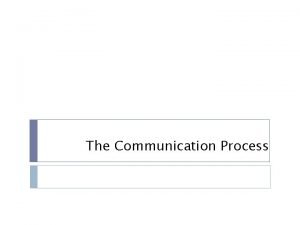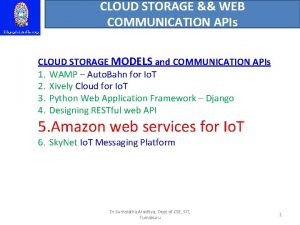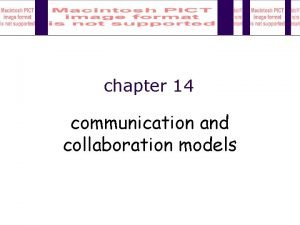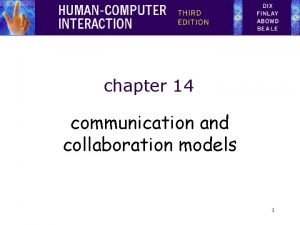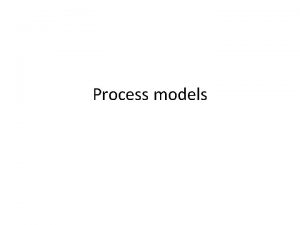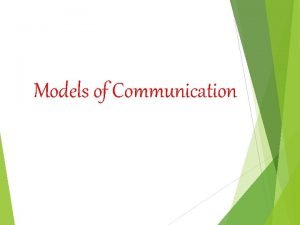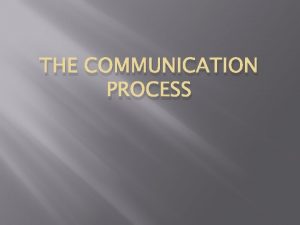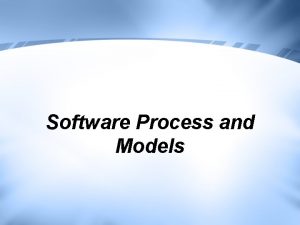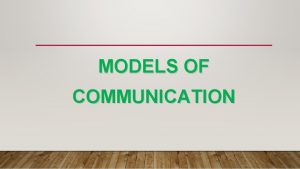Communication Part 2 Process and Models Communication Process









- Slides: 9

Communication Part 2: Process and Models

Communication: Process& Models �The Linear View • Sender encodes ideas or feelings into a message • Message is injected via a channel to a receiver • The receiver decodes the message Noise encodes Sender Noise message Noise decodes Receiver

Communication: Process & Models � Noise: Noise anything that gets in the way of the message • External-anything outside External that makes it hard to hear or concentrate (talking in a movie, someone smoking) • Physiological-physical things Physiological inside a person (illness) • Psychological-mental or Psychologicalemotional states that make it hard to listen � Think about it • What are some things that make it hardest for you to listen?

Communication: Process & Models � Interactive View • Replaces encodes with behavior to capture • • • unintentional things like expressions or body language Adds idea that sender also gets feedback (verbal or nonverbal response) from the receiver and adjusts the message Environment also plays a role-These are “fields of experience that help them understand another’s behavior. ” These includes not just where you are, but also what experiences and culture you are coming from Think about it: How are noise and environment similar and different?

Communication: Process & Models Noise Behaves Noise message Noise Decodes Sender Receiver Sender Decodes A’s environment message Behaves B’s environment

Communication: Process & Models � Transactional View • Similar to interactive view, except that responding and decoding are happening at the same time for both people • Communication is not a series of individual acts, but a constant sending and receiving of messages all at the same time

Communication: Process & Models Noise Sender Responds Decodes A’s environment Noise message Noise Decodes Responds Receiver B’s environment

Communication: Process & Models �Final Definition of Communication: • Continuous, transactional process involving participants who occupy different but overlapping environments and create a relationship by simultaneously sending and receiving messages, many of which are distorted by external physiological and psychological noise.

Communication: Process & Models � LISTENING SKILLS DRAWINGS: You will need a piece of paper and a writing utensil for each participant. You also will need two different diagrams for each pair. Have partners sit back to back and decide who will be the “listener” and who will be the “talker” first. Each will eventually have a chance to play both roles. Give each “talker” a copy of a diagram. The Listener must sketch what they hear described, and in this round 1, is not allowed to speak or ask questions. This pair is using “one-way communication. ” There will be 1 -2 minutes allotted for this round, or longer if time permits. Partners compare drawings when finished to see how close they came to the original. The second round can begin and partners switch roles, still sitting back to back. The dyad together must try to improve results. In this round 2, the talker gets different diagram, and the listener can speak and ask questions. After the allotted time has passed, partners should compare results again. Then bring the two groups together to talk about the benefits of both types of communication.
 Difference between modal and semi modal verbs
Difference between modal and semi modal verbs Traditional response hierarchy models
Traditional response hierarchy models What is interactive communication model
What is interactive communication model Cloud storage models and communication apis
Cloud storage models and communication apis Communication and collaboration models
Communication and collaboration models Communication and collaboration models
Communication and collaboration models Part part whole addition
Part part whole addition Unit ratio definition
Unit ratio definition Part part whole
Part part whole Technical description
Technical description

